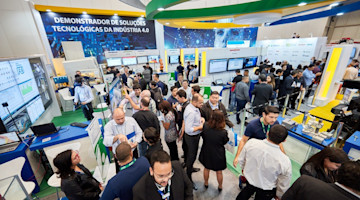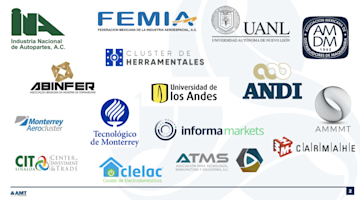AMT’s Hubert Sawicki was recently in Moscow for the Metalloobrabotka show, which is Russia’s primary machine tool exhibition. After a five-year hiatus from AMT participation in the show, it was time to revisit the market and lend support to the more-than-a-dozen AMT members exhibiting their wares. His impressions were somewhat surprising and generally positive.
The 2019 show had a net exhibition space of 456,000 SF with 1,186 exhibitors and attracted more than 35,000 visitors from 33 countries. The AMT exhibitors expressed satisfaction with the show and the local market potential. Russia is still the world’s 10th largest consumer of machine tools ($1.8 billion in 2018) and imports account for almost 80 percent of that. The most successful American manufacturers exporting to Russia have succeeded through the proper selection of channel partners, something AMT can assist with.
It is no secret that Russia is less prosperous than before the sanctions. From its peak in 2014, machine tool consumption has decreased by 22 percent. However, the main industrial sectors using manufacturing technology have large investments planned that represent opportunities for AMT members.
The civil aerospace industry is projected to see growth through 2021. There is a multibillion-dollar program to increase production facilities for all types of transportation (rail, sea, and road). As of 2018, a strategy has been adopted to greatly increase local production to supply the automotive industry with parts and components, and large incentives for foreign investment to build modern cars, including EV and autonomous. A massive program has been launched to modernize Russia’s power generation through 2024 which includes large turbine production.
In 2018, the largest factory investments in Russia were in electric motors, HVAC, chemical, metalworking, civil engineering, medical, electronics, and machine building. Finally, there is a technology development program with a large budget for subsidies and preferential credit set aside for buying machine tools of a higher technical class.
Should your company do business in Russia?
Members have expressed concern about exporting to Russia due to uncertainty and excessive export controls. The export control regulations certainly are confusing and occasionally seem contradictory. But, many exporters’ concerns are unfounded. That is not to say that exporters to Russia need not be particularly cautious. There is no substitute for knowing the identity of the end-user of your product and the end use to which it is likely to be put.
Exporters should stay current with the latest news and developments concerning Russia, due to inherent political risks and the possibility that either presidential or congressional attitudes toward Russia could change dramatically in a very short time. Actual export control policy changes would be reflected in statements posted on the Commerce Department’s Bureau of Industry and Security (BIS) website. Relevant information may also be found on the Treasury Department’s Office of Foreign Assets Control (OFAC) website. Sanctions enforcement policy is shared between these two departments.
While it is possible to navigate the uncertain waters concerning exports to Russia, key factors in your calculation are subject to the political winds and could change accordingly. The Russian government could embark on a new, aggressive foreign policy. Congress or the president could react with sanctions against Russia, or even with new parameters imposed on previously legitimate and licensed exports. To further complicate this, President Trump has expressed disagreements with Congress over the proper targets and technical parameters for export controls to Russia, with the president wanting to ease sanctions and Congress expressing a desire to make existing sanctions even tougher.
To date, the compromise between the White House and Congress has been to impose sanctions against particular individuals or entities, rather than to impose them across a broad list of technologies and products. That results in the sanctions being narrow in scope, catching individuals and their businesses rather than broad categories of products and technologies, as is the case with most non-Russian export controls.
Here are the broad areas that are prohibited for business interaction
Anyone on the entities list and any business in which blacklisted individuals have more than a 50 percent interest are prohibited.
Certain types of microprocessors that have military application, deep-water and artic drilling, and some types of oil pipeline equipment are also problematic.
Obviously, anything that has to do with supplying the military or Russian space program is not allowed. This last prohibition did not prevent Boeing from entering into a cooperative manufacturing project to machine inexpensive Russian titanium for U.S. and Russian commercial aerospace. Thus, it is possible to work out business deals that profit both sides, as long as the military is not involved, and the U.S. government is well informed about the details of the business arrangement.
As a general rule, most types of machine tools to non-military and non-sanctioned entities are likely to be licensable. Current export control laws allow export to Russia if you are careful and undertake due diligence, although it may take longer than usual due to the scrutiny and caution of the U.S. government’s licensing process.
Visit the Bureau of Industry and Security website for more information: www.bis.doc.gov.
Is your product subject to export controls?
The technical performance parameters for exports to Russia are listed on the Commerce Department’s Bureau of Industry and Trade (BIS) website. The website also includes the blacklisted entities and individuals to whom exports are forbidden.
For exporters, the problem with this “entities list” approach is that it is not always clear or easy to determine the degree of ownership of these targeted individuals. That is an intelligence task that is difficult to carry out. The sanctions regulations state that you cannot export to any company owned by blacklisted people named by the U.S. government. But 50 percent, or more, is the criterion for ownership, and it is up to the exporter to ascertain that degree of ownership, not the U.S. government.
How to learn more
AMT may have useful information on the ownership question, and we will do our best to obtain the relevant information for you. There are also established consulting companies who provide such ownership data for a fee. The important thing is for you to be able to demonstrate to a government investigator or auditor that you made a good faith effort to obtain that data and that you did not bury your head in the sand if, and when, suspicious information became available.
For further information on the local market conditions and in-country assistance, contact Hubert Sawicki of AMT at hsawicki@amtonline.org. For assistance with export licensing and sanction issues contact Paul Freedenberg at phf0217@gmail.com.






